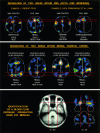Functional anatomic studies of memory retrieval for auditory words and visual pictures
- PMID: 8815903
- PMCID: PMC6579164
- DOI: 10.1523/JNEUROSCI.16-19-06219.1996
Functional anatomic studies of memory retrieval for auditory words and visual pictures
Abstract
Functional neuroimaging with positron emission tomography was used to study brain areas activated during memory retrieval. Subjects (n = 15) recalled items from a recent study episode (episodic memory) during two paired-associate recall tasks. The tasks differed in that PICTURE RECALL required pictorial retrieval, whereas AUDITORY WORD RECALL required word retrieval. Word REPETITION and REST served as two reference tasks. Comparing recall with repetition revealed the following observations. (1) Right anterior prefrontal activation (similar to that seen in several previous experiments), in addition to bilateral frontal-opercular and anterior cingulate activations. (2) An anterior subdivision of medial frontal cortex [pre-supplementary motor area (SMA)] was activated, which could be dissociated from a more posterior area (SMA proper). (3) Parietal areas were activated, including a posterior medial area near precuneus, that could be dissociated from an anterior parietal area that was deactivated. (4) Multiple medial and lateral cerebellar areas were activated. Comparing recall with rest revealed similar activations, except right prefrontal activation was minimal and activations related to motor and auditory demands became apparent (e.g., bilateral motor and temporal cortex). Directly comparing picture recall with auditory word recall revealed few notable activations. Taken together, these findings suggest a pathway that is commonly used during the episodic retrieval of picture and word stimuli under these conditions. Many areas in this pathway overlap with areas previously activated by a different set of retrieval tasks using stem-cued recall, demonstrating their generality. Examination of activations within individual subjects in relation to structural magnetic resonance images provided an-atomic information about the location of these activations. Such data, when combined with the dissociations between functional areas, provide an increasingly detailed picture of the brain pathways involved in episodic retrieval tasks.
Figures








Similar articles
-
Lateralization of prefrontal activity during episodic memory retrieval: evidence for the production-monitoring hypothesis.J Cogn Neurosci. 2003 Feb 15;15(2):249-59. doi: 10.1162/089892903321208187. J Cogn Neurosci. 2003. PMID: 12676062 Clinical Trial.
-
An information-processing model of three cortical regions: evidence in episodic memory retrieval.Neuroimage. 2005 Mar;25(1):21-33. doi: 10.1016/j.neuroimage.2004.11.001. Epub 2005 Jan 25. Neuroimage. 2005. PMID: 15734340
-
Neural correlates of semantic and episodic memory retrieval.Neuropsychologia. 1999 Jan;37(1):103-18. doi: 10.1016/s0028-3932(98)00044-x. Neuropsychologia. 1999. PMID: 9920476 Clinical Trial.
-
The functional neuroanatomy of episodic memory: the role of the frontal lobes, the hippocampal formation, and other areas.Neuroimage. 1998 Aug;8(2):198-213. doi: 10.1006/nimg.1998.0359. Neuroimage. 1998. PMID: 9740762 Review.
-
Noun and verb retrieval by normal subjects. Studies with PET.Brain. 1996 Feb;119 ( Pt 1):159-79. doi: 10.1093/brain/119.1.159. Brain. 1996. PMID: 8624678 Review.
Cited by
-
Management of attentional resources in within-modal and cross-modal divided attention tasks: an fMRI study.Hum Brain Mapp. 2007 Dec;28(12):1267-75. doi: 10.1002/hbm.20350. Hum Brain Mapp. 2007. PMID: 17315224 Free PMC article.
-
Tinnitus distress is associated with enhanced resting-state functional connectivity within the default mode network.Neuropsychiatr Dis Treat. 2018 Aug 1;14:1919-1927. doi: 10.2147/NDT.S164619. eCollection 2018. Neuropsychiatr Dis Treat. 2018. PMID: 30122924 Free PMC article.
-
Cortical midline structures and autobiographical-self processes: an activation-likelihood estimation meta-analysis.Front Hum Neurosci. 2013 Sep 4;7:548. doi: 10.3389/fnhum.2013.00548. Front Hum Neurosci. 2013. PMID: 24027520 Free PMC article. Review.
-
Neural correlates of the episodic encoding of pictures and words.Proc Natl Acad Sci U S A. 1998 Mar 3;95(5):2703-8. doi: 10.1073/pnas.95.5.2703. Proc Natl Acad Sci U S A. 1998. PMID: 9482951 Free PMC article.
-
Distinct changes in the morphology of cortical and subcortical grey matter associated with age-related hearing loss and tinnitus in the UK Biobank participants.Brain Commun. 2025 May 27;7(3):fcaf203. doi: 10.1093/braincomms/fcaf203. eCollection 2025. Brain Commun. 2025. PMID: 40496672 Free PMC article.
References
-
- Andreasen NC, O’Leary DS, Cizadlo T, Arndt S, Rezai K, Watkins GL, Boles Ponto LL, Hichwa RD. Remembering the past: two facets of episodic memory explored with positron emission tomography. Am J Psychiatry. 1995b;152:1576–1585. - PubMed
-
- Buckner RL. Beyond HERA: contributions of specific prefrontal brain areas to long-term memory retrieval. Psych Bull Rev. 1996;3:149–158. - PubMed
-
- Buckner RL, Petersen SE. What has neuroimaging told us about prefrontal cortex involvement in long-term memory retrieval? Semin Neurosci. 1996;8:47–55.
Publication types
MeSH terms
Grants and funding
LinkOut - more resources
Full Text Sources
Medical
